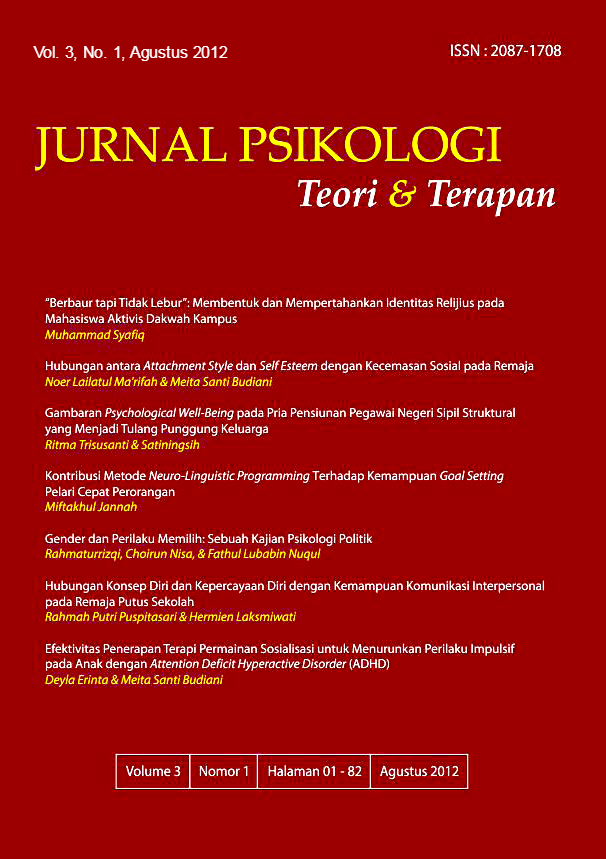KONTRIBUSI METODE NEURO-LINGUISTIC PROGRAMMING TERHADAP KEMAMPUAN GOAL SETTING PELARI CEPAT PERORANGAN
DOI:
https://doi.org/10.26740/jptt.v3n1.p42-48Keywords:
Neuro-Linguistic Programming, Kemampuan goal setting, pelari cepat peroranganAbstract
This research was designed to test the contribution of Neuro-Linguistic Programming (NLP) to individual 100 meter sprinters goal setting abilities. There were fourteen individual 100 meter sprinters from Local Training Center of East Java participated in this research. Data were analysed using difference mean pretest and posttest goal setting ability score. The result obtained indicates that: (1) mean pretest goal setting ability score=6; (2) mean postest goal setting ability score=12,5; (3) mean gain score=6,5. There was difference individual 100 meters sprinters goal setting ability between before and after received NLP training. This study concluded that NLP training contributes to increase individual 100 meter sprinters goal setting abilities.Abstrak: Penelitian ini dirancang untuk menguji kontribusi Neuro-Linguistic Programming (NLP) terhdap kemampuan goal setting pelari cepat 100 meter. Ada empat belas pelari cepat individual 100 meter dari Pusat Latihan Daerah Jawa Timur yang berpartisipasi dalam penelitian ini. Data dianalisis dengan menggunakan skor rata-rata perbedaan antara pretest dan posttest kemampuan goal setting. Hasil yang diperoleh menunjukkan bahwa: (1) skor rata-rata pretest kemampuan goal setting = 6; (2) skor rata-rata posttest kemampuan goal setting = 12,5; (3) sko rata-rata selisih antara pretes dan postes = 6,5. Hasil tersebut menunjukkan ada perbedaan kemampuan goal setting pelari cepat individual 100 meter antara sebelum dan sesudah pelatihan NLP diterima. Setelah pelatihan NLP, kemampuan goal setting partisipan meningkat. Penelitian ini menyimpulkan bahwa pelatihan NLP dapat meningkatkan kemampuan goal setting pada pelari cepat 100 meter perorangan.
References
Bompa, T. O. & Haff, G. G. (2009). Periodization: Theory and Methodology of Training. 5th Edition. Champaign, IL: Human Kinetics.
Burton, D. & Naylor, S. (2002). œThe Jekill/Hyde Nature of Goals: Revisiting and Updating Goal-Setting in Sport. In T. Horn (Ed.). Advanced in Sport Psychology (2nd ed., hlm. 459-500). Champaign, IL: Human Kinetics.
Burton, D. (1989). œWinning isnt Everything: Examining the Impact of Performance Goals on Collegiate Swimmers Cognition and Performance. The Sport Psychologist, 3, 105-132.
Cox, R. H. (2002). Sport Psychology, Concept and Applications. Boston, MA: McGraw- Hill.
Haag, H. (1994). Theoretical Foundation of Sport Science as a Scientific Discipline Contribution to a Philosophy (Meta-Theory) of Sport Science. Federal Republic of Germany: Verlag Karl Hofmann Schondorf.
Hayes, P. & Rogers, J. (2006). NLP (Neuro-Linguistic Programming for the Quantum Change. Champaign, IL: Human Kinetics.
Locke, E. & Latham, G. P. (2002). œBuilding a Practically Useful Theory of Goal Setting and Task Motivation: A 35 Year Odyssey. American Psychologist, 57(9), 705-717.
Malisoux, L., Francaux, M Malisoux, L., Francaux, M., Nielson, H., Theisen, D. (2006). œStrech-Shortening Cycle Exercises: An Effective Training Paradigm to Enhance Power Output of Human Single Muscle
Fibers. Journal Applied Physiology, 100 (3), 771-779.
McKenzie, A. & Hodge, K. (2000). œGoal setting. In A. McKenzie, K.Hodge, & G. Sleivert (Eds.). Smart Training for Rugby: Complete Training Guides for Players and Coaches and Athletes (hlm. 24-36). Birkenhead Auckland, Reed: Penguin Group Publishing.
Weinberg, R. S. & Gould, D. (2003). Foundations of Sport and Exercise Psychology. Champaign IL: Human Kinetics.
Weinberg, R.S. & Weigand, D. (1993). œGoal Setting in Sport and Exercise: A Reaction to Locke. Journal of Sport and Exercise Psychology, 15, 88-96.
Weinberg, R. S. (2004). œGoal Setting Practices for Coach and Athletes. In T. Morris & J. Summer (Eds.). Sport Psychology (2nd ed., hlm. 278-290). New York, NY: John Wiley & Sons, Ltd.
Wood, R. & Locke, E. (1990). œGoal Setting and Strategy Effect on Complex Tasks. In B. Staw & L. Cumming (Eds.). Research in Organizational Behavior (vol. 12, hlm. 73-109). Greenwich, CT: JAI Press.
Vancouver, J.B., Thomson, C.M. & Amy, A.W. (2001). œThe Changing Sign in Relationship Among Self Efficacy,
Downloads
Published
How to Cite
Issue
Section
License
Authors who publish in this journal agree to the following terms:
Copyright in any article is held by the author.
The author grants the journal, publication rights with the work simultaneously licensed under a Creative Commons Attribution License that allows others to share the work with an acknowledgment of the work's authorship and initial publication in this journal.
Authors may enter into separate, additional contractual arrangements for the non-exclusive distribution of the journal's published version of the work (e.g., posting it to an institutional repository or publishing it in a book), with an acknowledgment of its initial publication in this journal.
Authors are permitted and encouraged to post their work online (e.g., in an institutional repository or on their website) prior to and during the submission process, as this can lead to productive exchanges, as well as earlier and greater citation of published work.
 Abstract views: 1545
,
Abstract views: 1545
, PDF Downloads: 985
PDF Downloads: 985


















